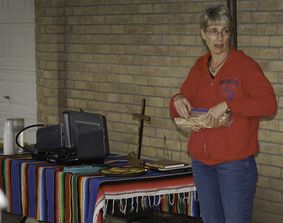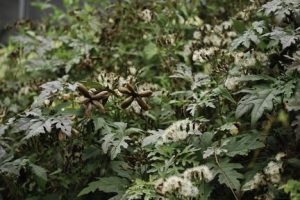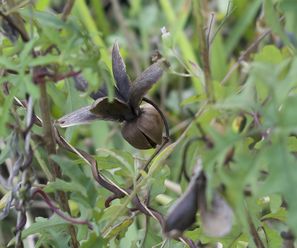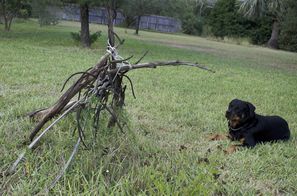
In February of 2015, I volunteered to be the Chapter representative for the 2015 Class field trip to Rancho Lomitas in Rio Grande City. I remember meeting Benito Trevino over some Ebony bean coffee and listening to Toni Trevino while enjoying her Honey Mesquite cookies. Their storytelling is excellent and brought their conservation efforts to life.

Around the Trevino home, Barbara Peet, a member of the Class of 2015, and I noticed their Woodrose (Merremia dissecta) growing on a trellis against their house. To see the brown woody seed pods and their resemblance to a rose, it is easy to see why it is called the Woodrose (aka, Alamo vine, Noyau vine, Correhuela de las Doce, Hierba de la tarantula). A member of the Morning Glory Family, this attractive, twining perennial has large white flowers with dark burgundy centers.

Though we were early in our Texas Master Naturalists journey, we wanted to try and grow this unique plant in our yard. We were given some seed pods and, having grown plants from seeds before, figured we would have our own Woodrose soon.
To add to our efforts, we found some Woodrose growing along an irrigation canal in South San Benito. We happened to look at the right time at the right place to see it blooming. (We’ve been back since and haven’t found it again.) We carefully dug up the vine with its nodules and runners and took it home. We had seed and we had a live sample of the vine, what else could we need?
With 2020 almost over, we have yet to grow our own plant.
It amazes me that we can offer our native plants ideal conditions, but that will not make them grow. Benito and Toni’s most intriguing stories are their trial and errors involving propagating some of the rarest plants in Texas. I believe their patience, visible in other growers like Mike Heep, is key in developing a systematic method for growing our unique plants. I do not share their patience. My plan to place a seed in good compost, provide rainwater, and plenty of sunlight, isn’t enough.
I can’t remember who first mentioned it to us, maybe Frank Wiseman or Christina Mild, but the thought of mowing at the highest level your mower offers or simply holding off mowing for a while, might reveal some hidden treasures in your own yard. We have found bluebonnets, ladies’ tresses, Texas poinsettia, and others.

A week or so ago, I found a new vine, some sort of morning glory but I wasn’t sure what species. I had to wait for Barbara to come home; she’s the one with the green thumb and greater knowledge of plants.
Barbara turned over the woody seed pod and instantly recognized it as a Woodrose! Out in the middle of our St. Augustine grass, this little vine, either patiently waiting for the right time, or gifted to us by a passing bird, had come to life.
Having found the vine in the middle of the yard, and based on past failures transplanting some of our finds, I built something the vine could climb. With our daughter’s Rottie supervising, I created a makeshift structure to not only allow the vine to grow but also keep me from accidentally forgetting where it is.

In the past, we’ve watered a forgotten pot to find the dead Huisache spring back to life. We’ve seen soil cleared of St. Augustine grass, covered in frog fruit, scorpion tail, and mistflower. The following year, we’ve had more butterflies than we could count. Sometimes all nature needs is a little help and nature will find its place.

Leave a Reply